Method for optimized local routing between mobile nodes
a local routing and mobile node technology, applied in the field of mobile management systems, can solve the problems of putting unnecessary burden on networks and routers, not facilitating mobile node to mobile node routing, and unrealistic to expect all mobile and correspondent nodes to have support for this feature of routing optimization
- Summary
- Abstract
- Description
- Claims
- Application Information
AI Technical Summary
Problems solved by technology
Method used
Image
Examples
first embodiment
[0036] In the present invention illustrated by reference to FIG. 4, the edge mobility agent is not configured for making a decision of whether to locally route for the mobile nodes known to the edge mobility agent. Instead, the home agent makes that decision in a manner described above by reference to FIGS. 2 and 3. Thus, in accordance with such an embodiment, the edge mobility agent receives an indication of a care-of address for a mobile node. This indication may be received, for instance, as a result of a registration request being sent from a mobile node to the mobile node's home agent via the EMA, upon the mobile node first switching to the EMA, or via some other conventional means. In this way, the mobile node becomes known to the EMA.
[0037] The EMA then determines whether it can perform local routing for the mobile node. In this instance, this comprises a simple determination of whether it has received from the home agent an instruction to locally route datagrams for the mobi...
second embodiment
[0038] In the present invention illustrated by reference to FIG. 4, the edge mobility agent is configured for making the decision of whether to locally route for the mobile nodes known to the edge mobility agent. The edge mobility agent may make this decision in a similar manner as the home agent, which was described above by reference to FIGS. 2 and 3. Accordingly, the edge mobility agent might determine whether local routing should be performed for this particular mobile node, for instance, based upon whether a need exists. Whether the need exists may depend upon one or more similar factors, as described above, or upon information available to the edge mobility agent. The edge mobility agent may, for instance, also examine itself to see whether it currently has the bandwidth to perform local routing for that particular mobile node, assuming the EMA is limited by a predetermined capacity.
[0039] If the edge mobility agent determines that it can perform local routing for the mobile n...
PUM
 Login to View More
Login to View More Abstract
Description
Claims
Application Information
 Login to View More
Login to View More - R&D
- Intellectual Property
- Life Sciences
- Materials
- Tech Scout
- Unparalleled Data Quality
- Higher Quality Content
- 60% Fewer Hallucinations
Browse by: Latest US Patents, China's latest patents, Technical Efficacy Thesaurus, Application Domain, Technology Topic, Popular Technical Reports.
© 2025 PatSnap. All rights reserved.Legal|Privacy policy|Modern Slavery Act Transparency Statement|Sitemap|About US| Contact US: help@patsnap.com



